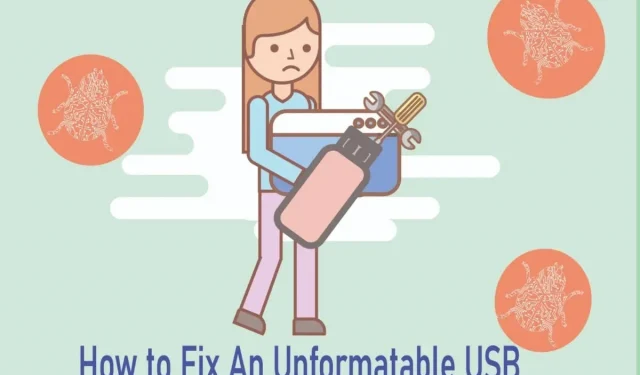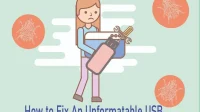Are you having problems formatting your USB drive or an unformatted USB drive error? This article covers all the causes, be it a virus or a bug, and then suggests the necessary solutions.
The USB flash drive is a portable device that allows users to save, copy and transfer documents and other multimedia files through a natural and secure connection. However, the drive may have some disadvantages.
Whenever you try to access a USB drive in Windows 10, you get a “Please insert a disc into your USB drive”or “Windows couldn’t complete the format”message during the formatting process.
In most cases, disk data has been corrupted. In addition, the drive could fail.
Why Do Unformatted USB Drive Errors Occur?
The USB flash drive can be repeatedly connected to Windows or other drives. You must determine the cause of this problem before correcting it.
When a flash drive shows an “Unformatted USB Drive”error, it could be due to several factors. However, you don’t have to go anywhere as we have explained all the reasons below:
1. There may be bad sectors
Frequent use of a USB flash drive can result in bad sectors that should be read/write.
2. You Might Have a Virus on Your USB Drive
There is a risk that your USB drive may be infected with a virus if your computer has previously been infected with a virus.
3. It’s a power surge
The critical circuit board of this tiny device, designed for a specific power range, can completely stop responding to a power surge for even a few nanoseconds if that power range is subjected to a sudden voltage spike.
4. Your device may also be offline
After using a USB flash drive, if it is removed without following the safe removal instructions, it may display 0 bytes.
Best Fixes for Unformatted USB Drive
- Detection of a corrupted USB drive
- Format the USB drive
- Use Diskpart Command
- Scanning and Repairing a USB Drive
- Use command line to recover data
- Use the command chkdsk /X /f
- Use Registry Editor to Disable Write Protection
- Scan USB virus
1. Detection of a corrupted USB drive
If your computer still detects your USB drive, you can determine if the drive is damaged.
- Visit This PC and navigate to your USB drive.
- Select “Properties”by right-clicking on it.
- Select “Hardware”from the top menu.
- Click the “Properties”button below to view the properties of your USB drive.
- Your USB drive is safe if it displays the message “This device is working properly.”
If you can’t browse the folder on your USB drive, there’s nothing to worry about. Follow the next few steps and you should be able to use the drive again in no time.
2. Format the USB drive
If the USB drive shows an unformatted USB drive, it is very important to format the USB drive. The steps to format a USB drive are as follows:
- Connect your flash drive to your computer and go to This PC to see the connected drive.
- Select your USB drive from the Devices and Drivers menu and right-click to open it.
- Select Format from the available options.
- From the File System menu, select the drop-down arrow.
- Select NTFS from the list of options. New Technology File System, NTFS for short, is the default file system for most fixed drives. It is compatible with most versions of Windows).
- Select the default option for allocation unit size from the next menu.
- Select “Volume Label”as the next option and optionally give your USB device a new name.
- Select the “Quick Format”option when formatting a drive from the “Format Options”menu. This will only delete the root folder and the system file table, not the data that Recoverit can recover.
- The “Quick Format”checkbox can be unchecked if you have previously recovered data using Recoverit and want to perform a full format of the USB drive.
- Finally, click the “Start”button below and confirm formatting the USB drive by clicking “Yes”.
3. Use the Diskpart Command
Windows ‘ built-in option to format a USB drive erases everything. Using a command line tool, you can solve the problem with an unformatted USB drive if you no longer need the data on the removable media.
- Insert the USB stick into your computer’s USB port.
- Launch Command Prompt as Administrator in Windows 10 by pressing Window + R.
- Paste diskpart into the dialog box, then press Enter. Eventually, it will launch a program called “Diskpart”which is a Microsoft partitioning utility.
- Then next to “Diskpart”type “list disks”. Using this feature, you can easily identify your USB stick by its size.
- After that, enter “select disk #”. Replace # with the numeric value of the removable drive.
Note. Make sure you don’t accidentally select the number of your computer’s hard drive, in this case “0”.
4. Scan and repair USB drive
You can use this solution to recover an unformatted USB drive on your PC as follows:
- Plug in your USB drive and open This PC to view it.
- Right-click the USB drive icon and select Properties.
- Go to the “Tools”tab in the menu above.
- The “Check”button is below the first rectangular error checking box. Click here.
- The scanning process of the USB drive should begin.
- The window must be closed manually after the successful completion of the scan.
- Finally, right-click on the USB drive icon under the Devices and Drivers group to manually “eject”the drive.
5. Use Command Prompt to Recover Data
CMD is a command line program that allows users to retrieve files from external devices after the Recycle Bin deletes the deleted files from the computer. Use this to fix the “Unformatted USB Drive”error.
- Plug in your USB flash drive and navigate to the Start menu taskbar icon.
- Type cmd in the search field and press Enter.
- This will open the cmd.exe file.
- Enter the following command:
| attrib -h -r -s /s /d (USB drive letter):\*.* |
- Press the “Enter”button to start automatic file recovery from the USB drive.
The Windows recovery process will be completed after completing all these steps. After a while, you will be able to recover your lost files from the USB drive.
6. Use the command chkdsk /X /f
If you are having problems with an unformatted USB drive, another option is to use the Windows command line method, which includes the following steps:
- Connect the USB drive to your computer.
- Right next to the Start menu icon is a search box. Type “cmd”in it and press the Enter key.
- When you run it, the command line application should open with the following prompt: C:\Users\(your PC name)>
- Then you need to enter the following command:
| chkdsk /X /f (letter of your flash drive) |
By doing this, Windows will perform a default check on the USB drive, fixing the file system on the drive. The command line will tell you that the file system has been fixed without any error messages.
7. Use Registry Editor to disable write protection.
Before proceeding with this method, try toggling the switch on the USB drive. Before proceeding, make sure you have disabled the physical write-protect switch on the USB drive, if it has one. To access the Registry Editor, follow these steps:
- Open the Windows Registry Editor on your PC.
- Press Win+R to open the search bar.
- Type Regedit in the search box.
- Click “Yes”to launch the Registry Editor.
- Click HKEY_LOCAL_MACHINE > SYSTEM > CurrentControlSet folder > Control folder.
- Open StorageDevicePolicies.
- In the right pane, right-click an empty area and choose New > DWORD from the context menu.
- Then type WriteProtect and click somewhere to save the DWORD.
- “0”should be entered as the sum of “Data Value”and click “OK”. The number zero must not be enclosed in quotation marks.
If you make changes in the Registry Editor, you usually need to restart your computer for the changes to take effect.
8. Scan USB virus
A USB drive can leave you vulnerable to malware if you use it to transfer files between multiple host devices. You can’t be too careful about USB security when dealing with sensitive data. Here’s how to scan a USB virus for viruses:
- Go to settings.
- Go to Windows Update from the top menu.
- Select Windows Security from the menu on the left.
- Select Virus & Threat Protection. A new window will open.
- Under the “Quick Scan”option button, you will see the scan options. Click here.
- Click the Windows Defender Offline Scan icon in the list.
- Click the Scan Now button.
Conclusion
In conclusion, we described ways to solve the problem with an unformatted USB drive. It is recommended that you do not throw away the USB flash drive when it becomes unusable and cannot be formatted.
Try the strategies listed above to diagnose the issue and recover your data. However, if the USB drive is a “damaged/damaged”flash drive, you will need to replace it with a new USB drive if it is damaged beyond repair.


